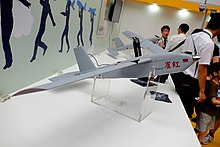NCSIST Cardinal
 From Wikipedia - Reading time: 6 min
From Wikipedia - Reading time: 6 min

Cardinal is a family of small unmanned aerial vehicles made by the National Chung-Shan Institute of Science and Technology (NCSIST).
Variants
[edit]Cardinal I
[edit]The Cardinal I was the initial prototype of the Cardinal.[1]
Cardinal II
[edit]The Cardinal II began development in 2009 and is based on the Cardinal I but has a better payload design, digital data link, and automatic tracking antenna system. It was exhibited at the 2015 Paris Air Show. In service with Republic of China Marine Corps[2] and Republic of China Army.[3] Other than military missions the Cardinal II can be used for civil remote sensing and disaster relief missions.[4]
The Taiwanese Navy procured 54 aircraft in 2016.[5]
The components of a Cardinal II system are the aircraft, an antenna, and a ground control box. The Cardinal II is hand launched and recovered by parachute. The aircraft is equipped with an autopilot and can transmit data and imagery in real time.[4] The remote control flight range is 8km.[6] In service a Taiwanese Cardinal II unit has six primary aircraft and three backups.[5]
Cardinal III
[edit]Cardinal III features vertical takeoff and landing capabilities. It is reportedly optimized for coastal surveillance.[7] It is intended for operation by the Marine Corps.[8] It was displayed at the Taipei Aerospace & Defense Technology Exhibition in 2023.[9]
Fire Cardinal
[edit]In 2019 NCSIST exhibited the Fire Cardinal for the first time at the Taipei Aerospace & Defense Technology Exhibition. It was referred to by NCSIST as an "air-to-ground assault" UAV, what is more commonly known as a loitering munition.[10] The Fire Cardinal is a twin-propeller drone about four feet long with a six-foot wingspan. It weighs around 15 pounds and includes an electro-optical and infrared sensor as well as advanced target discrimination systems.[11]
Specifications (Cardinal II)
[edit]General characteristics
Performance
- Maximum speed: 55 km/h (34 mph, 30 kn)
- Range: 50 km (31 mi, 27 nmi)
See also
[edit]References
[edit]- ^ "Cardinal Mini Unmanned Aircraft Systems". www.ncsist.org.tw. NCSIST. Retrieved 16 January 2020.
- ^ a b c d e f g h "Cardinal II Unmanned Aircraft System". www.ncsist.org.tw. NCSIST. Retrieved 16 January 2020.
- ^ Ng, JR (August 2019). "Asia-Pacific Unmanned Aerial Vehicle Directory 2018". Asia Military Review: 14–27. Retrieved 17 January 2020.
- ^ a b "Cardinal II" (PDF). www.ncsist.org.tw. NCSIST. Retrieved 16 January 2020.
- ^ a b Strong, Matthew. "Taiwan military plans Cardinal drones upgrade". taiwannews.com.tw. Taiwan News. Retrieved 31 July 2024.
- ^ Elaine Hou and Kuo Chung-han, Rita Cheng. "New U.S. drone sale policy could be good for Taiwan". focustaiwan.tw. Focus Taiwan. Retrieved 17 January 2020.
- ^ Cheung, Eric. "Taiwan unveils its new combat and surveillance drones as China threat grows". cnn.com. CNN. Retrieved 14 March 2023.
- ^ DOMINGUEZ, GABRIEL. "Taking page from Ukraine, Taiwan shows off new killer drones". japantimes.co.jp/. Japan Times. Retrieved 14 March 2023.
- ^ Kajal, Kapil. "TADTE 2023: NCSIST displays new UASs". janes.com. Janes. Retrieved 15 September 2023.
- ^ Wong, Kelvin. "TADTE 2019: NCSIST unveils Fire Cardinal mini-UAV". www.janes.com. Retrieved 16 January 2020.
- ^ MAKICHUK (22 October 2019). "Taiwan builds lethal fleet of kamikaze drones". www.asiatimes.com. Asia Times. Retrieved 16 January 2020.
 KSF
KSF